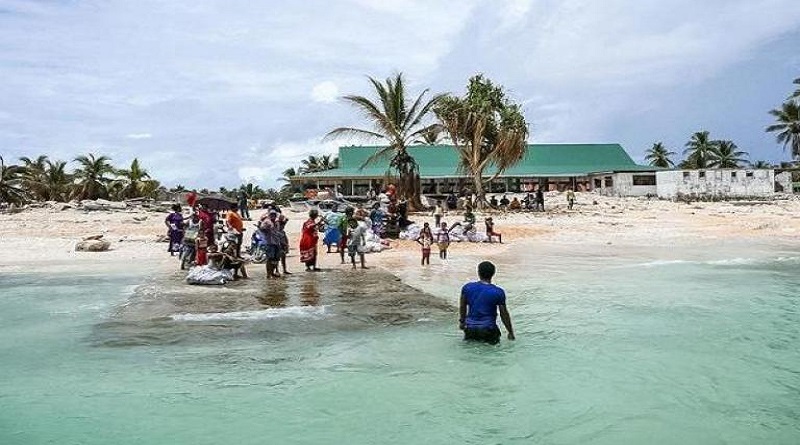WMO promotes Early Warnings for All at Conference on Small Island Developing States
Photo caption: People gather on a concrete pier extending into the water from a sandy beach with palm trees and a green-roofed building in the background. One person stands in the shallow water near the pier.
A major international conference takes place this week in Antigua and Barbuda to agree a new plan of action to build the resilience of small islands in tackling the world’s most pressing challenges and achieving the Sustainable Development Goals.
“The United Nations stands with you in reaffirming SIDS’ aspirations: to halt and mitigate the terrible impacts of the climate crisis; to build resilient economies; to foster safe, healthy and prosperous societies; to achieve water, food and energy security; to conserve biodiversity; and to protect and sustainably use the ocean and its resources,” said UN Secretary-General António Guterres in an opening address on 27 May.
A WMO delegation is participating in the Fourth International Conference on Small Island Developing States (SIDS4) to promote the need to accelerate progress in the Early Warnings for All initiative to ensure that every person on Earth is covered by life-saving early warning systems, including vulnerable communities worldwide on Small Island Developing States.
A devastating landslide in Papua New Guinea, with hundreds of people feared dead, highlighted once again the need for early warnings. Heavy rains played a role in the tragedy.
The conference in St. Johns takes place ahead of what is forecast to be a very active hurricane season. Just one landfalling hurricane can undermine years of socio-economic development in SIDS.
“SIDS face many challenges exacerbated by climate change. Their limited landmass, fragile ecosystems, and often narrow resource bases make them disproportionately vulnerable to the impacts of extreme weather events, rising sea levels, and shifting precipitation patterns. These threats not only endanger lives but also jeopardise the very existence of these nations, disrupting economies and displacing communities,” says WMO Deputy Secretary-General Ko Barrett.
“Early warning systems serve as a lifeline for SIDS, providing timely and accurate information to governments, communities, and other stakeholders. These systems play a crucial role in saving lives and mitigating the socio-economic impacts of disasters by facilitating proactive measures such as evacuation plans, resource allocation, and infrastructure reinforcement,” says Ko Barrett, who coordinates WMO Early Warnings for All action.
However, despite their critical importance, early warning systems are far from widely available, with only one-third of SIDS reporting the existence of such systems in their countries. This disparity underscores the urgent need for concerted action to bridge the gap in early warning infrastructure and services.
Small island developing States are home to approximately 65 million people. Many SIDS are still reeling from the double shocks of the global financial crisis and the COVID-19 pandemic, as well as struggling with accelerating climate change.
Green background with a quote by United Nations Secretary-General António Guterres: “We cannot accept the disappearance of any country or culture under the rising waves.” Date: 27 May 2024.
Scaling up climate finance
The SIDS4 conference brings together world leaders, development agencies, the private sector and civil society to address critical SIDS-specific challenges including the climate crisis, biodiversity loss and spiraling debt.
WMO will host a high-level side event on 30 May: Scaling up climate finance support for Early Warnings for All in SIDS. The UN Office for Disaster Risk Reduction, International Red Cross and Red Crescent Society, and the Caribbean Meteorological Organization are among the panelists.
“Sustained investments in infrastructure, technology, capacity building, and institutional frameworks are required. Moreover, tailored approaches are needed to account for the geographical and climatic diversity within SIDS, ensuring that early warning systems effectively address region-specific hazards,” says Daniel Kull, WMO Director of Resource Mobilization.
In this context, initiatives such as the Climate Risk and Early Warning Systems (CREWS), Weather Ready Pacific Programme, and the Systematic Observations Financing Facility (SOFF) are vital in supporting SIDS in enhancing their early warning capabilities. They mobilise financial resources, technical expertise, and political support to strengthen early warning services, which empower communities to prepare for and adapt to climate risks.
Early warning solutions must be localized and integrate traditional and indigenous knowledge. They need to be accessible, understandable, and actionable for the communities they aim to serve, particularly in SIDS where community knowledge and engagement are essential to translate early warning into early action.
As part of the Early Warnings for All initiative, there is a need to enhance the ocean observation network, which is currently in decline in SIDS, according to Mr. Rodney Martinez, Representative for North America, Central America and the Caribbean, World Meteorological Organization (WMO). This impacts on SIDS’ ability to predict extreme weather and climate events and take preventative actions.
Flash Flood Guidance System
Empowering SIDS for Resilience: Harnessing data and digital technologies to mitigate flash flood risks – Flash Flood Guidance System is the theme of a second side-event on 30 May by WMO in conjuction with USAID.
Flash floods represent significant hazards, resulting in the loss of over 5 000 lives annually and imposing significant social, economic, and environmental consequences. Accounting for about 85% of flooding incidents, flash floods have the highest mortality rate among various flooding types, including coastal flooding.
WMO’s Flash Flood Guidance System with global coverage is an important tool for providing operational forecasters and disaster management agencies with real-time informational guidance products on the threat of small-scale flash flooding.
“Since its inception in 2007, the FFGS has been implemented in 73 countries, including 15 SIDS nations, encompassing a population of 3 billion people. By harnessing diverse data sources such as satellite, radar data, automatic weather stations, numerical weather prediction models, and Geographic Information Systems (GIS), the FFGS equips SIDS countries to provide timely and precise flash flood warnings to vulnerable populations,” says Hwirin Kim, Head, Hydrological and Water Resources Division.




